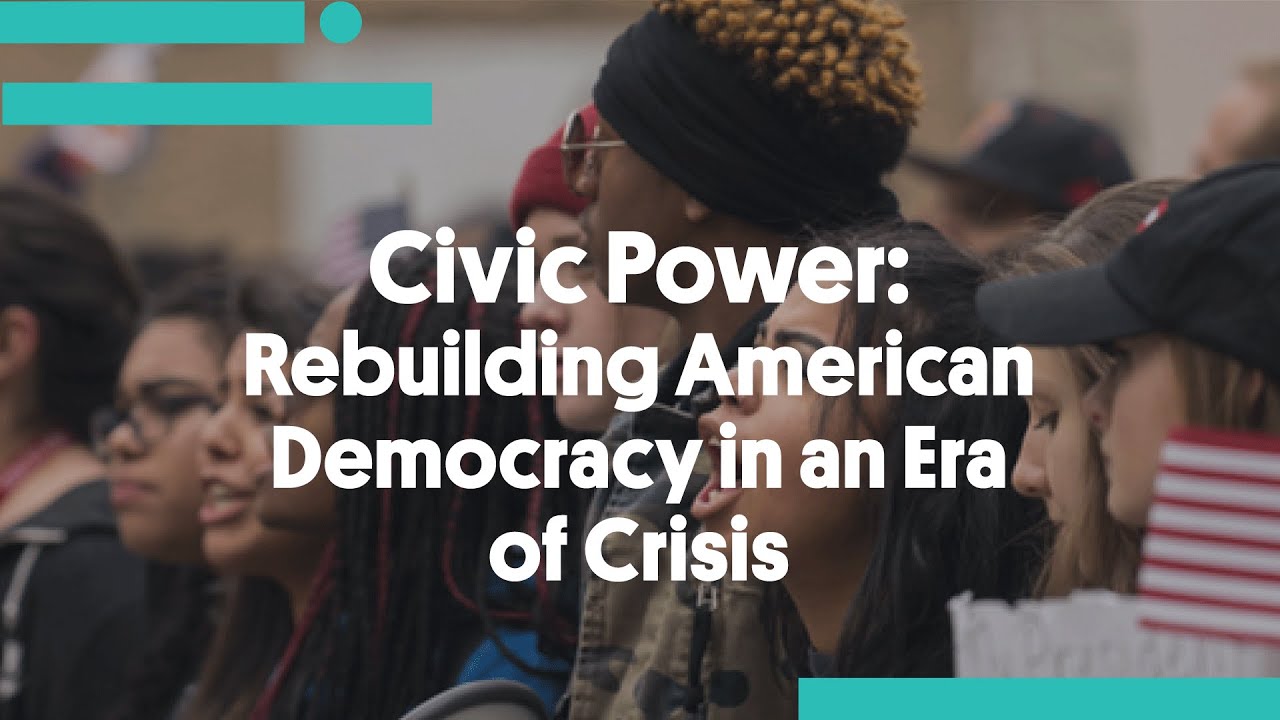In this excerpt from the book Civic Power: Rebuilding American Democracy in an Era of Crisis, authors K. Sabeel Rahman and Hollie Russon Gilman discuss restoring American democracy and rescuing it from crisis.
As the country barrels forward through possible impeachment proceedings against President Donald Trump and with a highly fractious and high-stakes 2020 election careening towards us, there is no question that American democracy is at a moment of crisis. But the crisis of our democracy is about much more than the chaos emanating from the current occupant of 1600 Pennsylvania Avenue, or the risk of a slide into autocracy. For too many Americans, democracy has been a value in name only, as our lived realities have been something very different. What does it mean to be a democracy where Black Americans—Like Atatiana Jefferson, in Dallas, Texas—can be murdered in their own homes by agents of the state? Or where an Amazon warehouse worker can be fired for falling behind on orders for even a few moments, their every movement surveilled and tracked, even as other workers can have a heart attack on the job and lie unassisted for over twenty minutes? Or where whole cities and communities can lie in debt and economic ruin as fodder for financial firm returns. The harsh reality is that there are elements of autocracy already here in America; it has just been unevenly distributed.
And that means that the task of (re)building our democracy is not just about the 2020 elections—though they are absolutely critical to our aspirations for an inclusive and equitable future. The task ahead requires much more than mobilizing voters and winning a Presidential election. It requires building and shifting power—in particular, the power of Black and brown communities and working families, where “we the people” really does mean all of us. It also requires creating an entirely different infrastructure that can sustain and deepen this power, and make it tangible and real for people in their daily lives. In our new book, Civic Power, we outline what this approach to building bottom-up democratic power could look like, and how it requires moving beyond conventional approaches to reform.
The Limits of “Good Governance”
One of the central challenges to a power-oriented approach to democracy reform comes from the conventions of reformers themselves. Often, democracy reform is animated by one of four common presumptions about what ails democracy and how to fix it:
-
The civility hypothesis— On this view, the theory is that American democracy is failing because of increased rancor and partisanship, which can be remedied by increasing good-faith dialogue and common sense, supplanting division, gridlock, and conflict.
-
The transparency hypothesis—On this variant, the theory is that by making governmental action more visible and subject to public opinion, we can improve governmental responsiveness and accountability.
-
The rationality hypothesis—On this approach, the central problem is that government lacks the expertise, information, and apolitical decision-making needed to serve the public good. The remedies then involve a range of interventions: increasing use of data and technocratic expertise, greater governmental insulation from and neutrality towards politics, attempts to depoliticize governmental bodies and actors.
-
The hijacking hypothesis— On this theory, the central problem with democracy is the undue influence of special interest groups, where once they are tamed or defused, the ordinary and correct processes of elections, public opinion, and accountability can resume.
Together these approaches to democracy reform comprise what we conventionally think of as a “good governance” ethos, a way of conceptualizing democracy’s failures and its remedies. While each of these approaches has some element of truth and value, there is a common limitation: they all to different degrees share a desire to purify policymaking of the vagaries of disagreement or conflict, in search of some apolitical and true form of democracy. Implicitly, these approaches all hold that deep down, the people are fundamentally in agreement around common-sense public policy, and if only there were greater information, data, and virtuous citizenship, free of the complications of interest group politics and partisanship, democracy would thrive.
But these approaches risk erasing another key reality: that politics is about who governs and who has power, and that democracy fails not just because of some technical limitations of our institutional system but because there are real interests who benefit from democracy’s failure. Furthermore, these approaches also imply a strangely narrow conception of what role the people themselves should play in democratic governance, imagining a sterilized and distant democratic public rather than a democracy that actively engages and empowers those most directly impacted.
These conceptual limitations of good governance reform have real political consequences, narrowing the scope of reform vision to more technical, technocratic reforms that while they may succeed in making government more “efficient”, do little to actually shift the balance of power in our society. There is also a sociological root to this: too often, democracy reform conversations can take place in more elite circles among policymakers, reformers, or institutions with more privileged backgrounds, rather than centering the voices of those most marginalized and affected, in ways that compounds the erasure of racial, gender, class, and power disparities.
By contrast, a power-oriented approach to democracy reform focuses not just on technical institutional design questions but on a broader look at how organizing, institutions, and democratic infrastructure can be remade to re-allocate decision-making power. Specifically, building power requires a multipronged approach: first, organizing people into empowered communities capable of exercising political voice and influence; and second, institutionalizing the power of grassroots communities to shape day-to-day policymaking and governance.
Organizing for Power
From the Movement for Black Lives to the Women’s March, the Red for Ed protests, the March for our Lives, and much more, we are in a moment of renewed grassroots mobilization and protest. These movements have radically changed the windows of political possibility, activating new voters and grassroots leaders, and shifting the outcomes of electoral and policy debates. It is a powerful reminder that building an inclusive democracy requires catalyzing, sustaining, and deepening the capacity of communities to exercise political influence.
While we often refer to a vague democratic “public opinion” to see what voters and communities want, the reality is that politics and public policy are shaped less by the inchoate and often inconsistent preferences of the public, and more by the balance of power among organized interest groups. Indeed, we can trace much of our current crisis of economic inequality and persisting racial inequity to the efforts of business groups to organize strategically over the last forty years through lobbying, campaign contributions, and more subtle techniques of regulatory and legal advocacy and capture to drive a business-friendly deregulatory agenda and help rollback advances of the civil rights movement. Public policy is consistently and demonstrably more responsive to the whims and desires of wealthier, and better organized Americans. Conservative policies like “right-to-work” laws and the loosening of antitrust and financial regulations are not just about economic policy; rather these are deliberate strategies to shift power by breaking the political efficacy of organized labor and unshackling the economic and political influence of big business.
It follows then that building an inclusive democracy requires a counter shift in political power towards the people themselves, both by constraining and breaking the concentrated power of the wealthy and of corporate interests and by deepening the organization and strategic capacity of grassroots communities. This, in turn, means taking a radically different approach to civic engagement.
Too often, civic engagement initiatives and funding streams focus on narrow goals of mobilization: registering and turning out voters, exhorting communities to be virtuous citizens by engaging in politics, and the like. And even more tragically, when we experience mass waves of mobilization—such as the 2008 Obama election—these surges of grassroots energy and activation have been kneecapped, converted into email fundraising machines rather than into genuine, grassroots organized capacity. A power-oriented approach to organizing instead focuses on investing directly in organizations and movements.
First, investing in grassroots groups and leaders empowers them to grow power and capacity within their own communities, centering those most directly affected. This means moving away from flash-in-the-pan moments of mobilization and last-minute efforts at voter turnout, and instead turning to year-round organizing to build collective power that can contest elections and exercise pressure on government in a more impactful and sustained way.
Second, deep relational organizing builds new leaders who emerge from their own communities over the course of movement-building and advocacy campaigns. These leaders are powerful voices for change, rooted in their communities, and have an exponential effect on expanding the imagination, vision, and impact of grassroots power.
Third, power-building organizing requires taking a sophisticated, strategic approach to advocacy campaigns, targeting not just visible forms of injustice, but also building the narratives, the public political education, and the capacity to tackle the hidden, structural drivers of exclusion and extraction. For example, new worker movements are focused not just on issues of wages but also on how the behind-the-scenes power of investors are driving the increasing precarity of work.
Fourth, this kind of deep organizing can create a new sense of shared fate and mutual solidarity while centering the most frontline communities, especially empowering black and brown communities and working families. By making visible the structural roots of on-the-ground inequities, and by creating a space and vehicle for collective action to address these problems, organizing can forge new bonds within and across constituencies bound together by a shared fate. Consider for example how new investments in climate resiliency succeeded in part because of organizing efforts that advanced an affordability and climate agenda in both the cities and suburbs, centering communities of color across the state.
Institutionalizing Power
Just as building power requires a deeper approach to civic engagement, it also requires shifting our conventional approaches to governing, policymaking, and institutional design. To shift power, we need to invest not just in organizing capacity but also in governance capacity, remaking our policymaking institutions to more directly center, empower, and engage frontline communities. If democracy is rule by “we the people,” then the actual day to day business of democratic policymaking must be more driven by the most affected constituencies. This in turn means taking a radically different approach to how we structure and operate administrative agencies and the policymaking bureaucracy.
Bureaucracies are in many ways at the heart of everything that is flawed about conventional democracy. Democracy reform tends to give elections, voting, and the federal legislature pride of place. And no doubt these institutions are critical for democracy to exist. But democracy and equitable power require more than well-functioning elections and legislatures. Administrative agencies—like the Environmental Protection Agency or municipal zoning boards or state labor commissions—are the actual frontline institutions of governance, where many of the most consequential decisions and policies are decided and actually implemented.
The centrality of governance institutions is not just procedural; these institutions are key in addressing substantive questions of inequality and exclusion. Without powerful civil rights enforcement agencies and offices, racial and gender discrimination and exclusion cannot be undone. Without an administrative regime to protect workers, or to provide universal access to public goods and the safety net, inequality increases. Given the importance of governance institutions in addressing the substantive, chronic, and structural dimensions of inequality and exclusion, it should be unsurprising that the dismantling of these institutions has been central to the political and policy strategy of the kinds of business interests and exclusionary politics
Yet these institutions are often overlooked in discussions of democracy reform. Too often, bureaucracies are left to either be vilified and dismantled by the Right, or further insulated from democracy under an apolitical, technocratic commitment by liberals to “good governance.” Instead, we need to reimagine an approach to bureaucracy that centers power and democracy, leveraging bureaucratic institutions as a way to further institutionalize direct decision-making authority for frontline communities. Bureaucracies themselves can be created, reformed and re-staffed to orient towards the need to redress disparities of democratic participation and power, and to bake this orientation more deeply into the day to day work of governing. To put it another way, we need to approach governance not just in terms of securing the policy wins for our campaigns and our communities, but rather in terms of remaking governing institutions themselves in ways that deepen our long-term power.
First, institutionalizing power requires embedding more points of leverage and influence that grassroots communities can use in the policymaking process itself. These “hooks and levers” can take different forms. For example, at different points in the past, social movements have briefly experimented with legislative and regulatory innovations that mandated stakeholder representation and participation: from the War on Poverty’s attempt at requiring “maximum feasible participation” of grassroots communities to the now-neutered Consumer Financial Protection Bureau’s efforts to engage frontline communities more directly in agenda-setting and policy design. At the local level, experiments in participatory budgeting and community power in shaping and monitoring urban development projects offer roadmaps for institutionalized forms of participation that embed more durable and effective forms of grassroots power.
Second, we need to remake the internal structure, personnel, and even culture of government itself to center these democratizing initiatives. Governing through more inclusive and participatory models that directly empower frontline communities requires significant investment and expertise on the part of conveners who design representative and participatory mechanisms, provide briefings for the participants on relevant data and issues, and facilitate discussion to lead to concrete, usable recommendations. Policymakers tend not to invest in these skills or tasks. To fully harness the potential of institutional design and policymaking for building countervailing power, this will have to change. If we are serious about democratizing governance, we will need to invest in people’s leadership development, both in current employees and in building a diverse talent pipeline—including imagining a world where grassroots leaders and organizers themselves are viewed as experts in their own right and positioned in high-level cabinet and regulatory positions themselves. It will also require moving governing bodies away from an obsession with efficiency, privatization, and technocratic decision-making to instead emphasize participation and equity.
Reclaiming Democracy’s Radicalism
True democracy reform must be transformative and bold enough to meet the challenges of the moment. Democracy is not going to be achieved by tinkering around the edges of existing economic, social, and political regimes. Neither optimizing government to make it more efficient, nor generating mass numbers of online petition signers will suffice. Democracy is a radical, transformative aspiration, committed to building the deep and durable power of grassroots communities to author their own destinies through the shared exercise of the powers and responsibilities of governance.
But radical democracy is not utopian; it is rather very real and achievable. That realness is often mundane: radical democracy can be found in the painstaking door-by-door work of organizing new movements, coalitions, and communities, of forging common identities, and of building the relationships and organizational muscles needed to assert political power. Radical democracy can be found in the work of policy design, optimized not for efficiency, but for inclusion. Radical democracy can be found in the work of bureaucratic culture-shifting, transforming staid government organizations into open and inclusive forums and counterparts, where communities can engage and participate in the business of decision making.
Indeed, these are broad aspirations; they will require significant organizing and advocacy work on the part of civil society actors as well as radical institutional and policy change on the part of governments. But this is not the first time America has faced a crossroads where the survival of democracy is at stake. Reconstruction after the Civil War, the Populist and Progressive movements culminating in the New Deal response to the upheavals of industrial capitalism, and the Civil Rights movement (and its successive inclusionary movements) of the 1960s and 1970s all represent major transformative moments when American democracy created new institutions that expanded its responsiveness and staved off the pathologies of corruption, systemic exclusion, and deliberate de-democratization. Whether today’s movements, organizations, and institutions will similarly be able to restore and even deepen American democracy in the twenty-first century remains to be seen.
If interested in reading more, you can find their book Civic Power: Rebuilding American Democracy in an Era of Crisis here.


